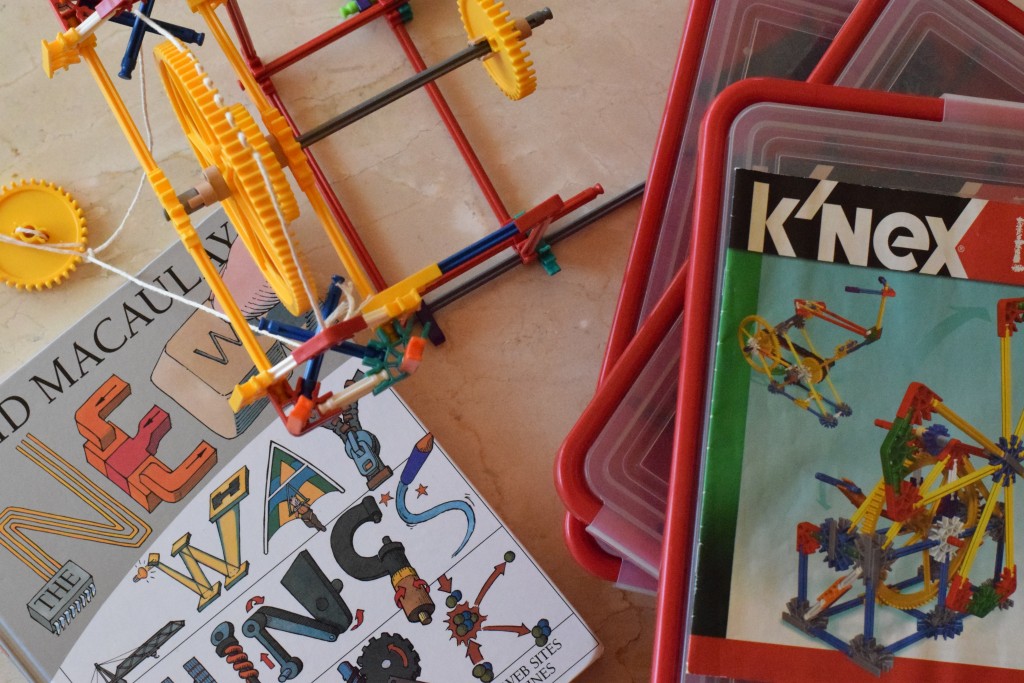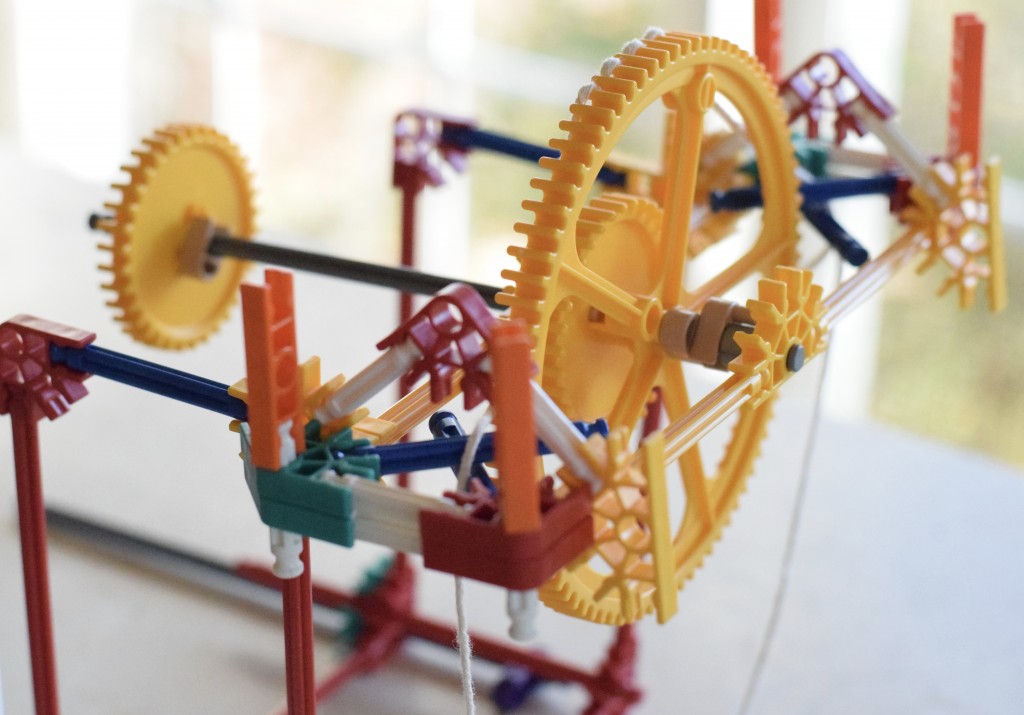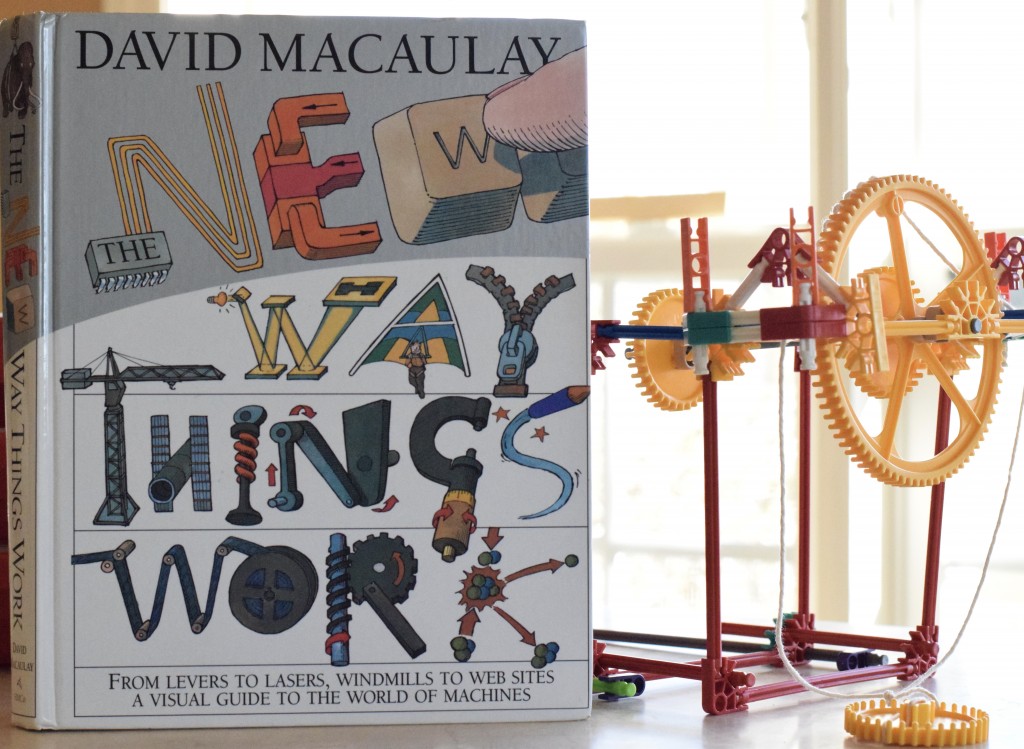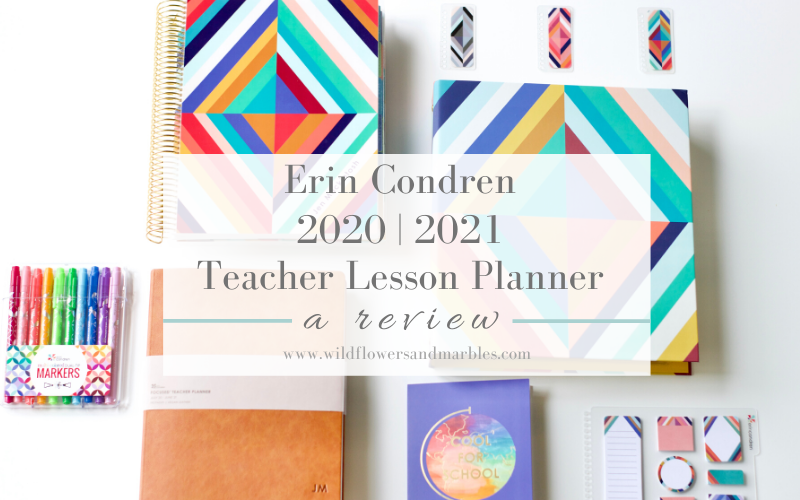Simple Machines with Fantastic Physics – Lesson Plans & Printable
If you’ve been a long time reader here, you may remember this post from six years ago – Boy Meets Machine. My then-10-year-old was enamored with a course I built around a fantastic book, The Way Things Work by David Macauley. The book naturally connected itself with some interesting hands-on Physics based explorations and some other fun reading that animated the Physics principles illustrated in Macauley’s book. My young son read and explored and built and was totally inspired! It lit a fire and that young 10 year old is now rapidly approaching 16, and is looking toward engineering as his career path! My second son is ready for a little “Boy Meets Machine” fun! So here we go again!
As I looked over my notes and plans from our first course six years ago, I wanted something a little more detailed. After all, when I built the first course I had no idea it would take on a life of its own. So I wrote some plans divided up across a 36 week school year, and added some fantastic (free) Physics explorations I found online that coordinate with the principles being discussed. I did my best to coordinate chapters and explorations with the discussion in Macauley’s books, and what I’ve come up with is super exciting to my son! I thought I’d share it with you in case it’s a help!
A quick word on the two (soon to be three) editions of this book:
The Way Things Work (here) VERSUS The New Way Things Work (here)
These lesson plans will work with either book, but I recommend The New Way Things Work if you’re purchasing this book for the first time. The Way Things Work was originally written in the late ’80’s, and at the time, computers were cutting edge technology and they were definitely not in everyone’s home. Today, not only do we have computers, but there are tablets, smart phones, and more. If you have access to either book, it’s helpful to note that the first 2/3 of both books are exactly the same! The New Way Things Work takes the entire first 2/3 of The Way Things Work verbatim (after all, inclined planes don’t change or update!), but the last 1/3 of the book on technology – the entire section titled, “The Digital Domain” (including computers), has been updated in The New Way Things Work (last edition was published 1998). The first two terms will work with either book. The last term of the lesson plans reflects the updates from The New Way Things Work,.
And guess what? David Macauley is about to publish a third book in his Way Things Work series, The Way Things Work Now. I’m pre-ordering (it will be available October 2016), and I’ll come back and update the lesson plans and this post once this book is issued! EXCITING! **edited to add that the lesson plans are updated (2/19) and now match the chapters in The Way Things Work Now**
THE DETAILS
This is a year long course and is suitable for middle school – the best ages: 6th – 7th graders although an advanced or science passionate 5th grader could complete it, too. This course is for anyone – it certainly isn’t limited to boys! It received the name, Boy Meets Machine, because…I first wrote it for my boys. 🙂 The name of the course now reflects the course itself so I hope that helps it reach all of you that are interested – whether you’re building science plans for boys or girls! All links are hot on the lesson plans – they direct you to the appropriate Physics exploration for that week. I’m also providing a detailed list of materials needed broken down by term…because I’m a mom, too, and if it’s going to get done around here, it better be on some kind of list. Can I get an amen? 🙂
PRINTABLE LESSON PLANS
Click below to download the free printable lesson plans
SIMPLE MACHINES MATERIALS LIST
CORE BOOKS
- The Way Things Work by David Macauley — OR –>
- The New Way Things Work by David Macauley
- An important note – if you only have the original book, The Way Things Work, you can still complete the course as written, but you may want to find some internet sources with updated info to supplement the tech chapters.
- Available for pre-order: The Way Things Work Now – which isn’t listed on these plans, but once the book is issued (October 2016), I will update the lesson plans to reflect this newly updated and revised edition.
- Can You Feel the Force? by Richard Hammond – this book is so engaging and captivating for this age group and topic! Not to be missed!
OPTIONAL BOOKS
- Usborne: Energy, Forces & Motion – these are excellent for digging further into Physics ideas because they’re internet linked and may provide further topics to explore. (I don’t require narrations from this book, because it’s mostly info blurbs which, though helpful, aren’t living ideas. And we all know that only living ideas can be narrated.)
- Usborne: Light, Sound & Electricity – see note above.
The following books are not listed on the lesson plans, but would make excellent supplements to this course:
- How Machines Work – Zoo Break! by David Macauley
- Built to Last by David Macauley
- See Inside How Things Work by Conrad Mason (for younger kids)
- How Stuff Works by Marshall Brain
- More How Stuff Works by Marshall Brain
CORE TOOLS – these kits contain all the parts and instructions to demonstrate many of the physics machines described in the first half of the book. They are an indispensable part of the course so that the student can read, apply, know.
- K’Nex Education – Introducation to Simple Machines: Levers and Pulleys kit
- K’Nex Education – Introduction to Simple Machines: Gears kit
- K’Nex Education – Introduction to Simple Machines: Wheels, Axles and Inclined Planes
- Other tools which are detailed on the Simple Machines Materials List.
PROJECTS & EXPLORATIONS – All of the projects listed for this course are noted below by week. They each coordinate with the principle discussed in the week’s reading. Most of the projects on the lesson plans are linked to free Scientific American explorations that demonstrate principles in this course. You will need to provide simple household items for each demonstration (materials list is provided above). At this age, most of these explorations can be completed independently. (Feel free to substitute other Physics explorations if desired.)
- Week 2 – K’Nex Kit: Inclined Plane
- Week 3 – K’Nex Kit: Levers
- Week 4 – K’Nex Kit: Wheel and Axle
- Week 5 – K’Nex Kit: Gears
- Week 7 – K’Nex Kit: Pulleys
- Week 8 – K’Nex Kit: Screws
- Week 9 – Provide a gyroscope toy
- Week 10 – Springs scavenger hunt – stapler, click pen, wind up toy car (possibly one you wouldn’t mind dissecting – you can find these inexpensively in the party favor section of any store.)
- Week 11 – Explore Friction By Launching Stuff & Phone Book Friction
- Week 14 – DIY hot air balloon – detailed instructions here
- Week 15 – Build a Paper Rocket & The Aerodynamics of a Flying Frisbee
- Week 16 – A Really Long Straw
- Week 17 – Stretch It! How Does Temperature Affect a Rubber Band?
- Week 18 – Half Life Coins
- Week 21 – youtube video: How Does a Camera Work?
- Week 23 – Sound Science: Do, Re, Mi with Straws
- Week 24 – Block Radio Waves
- Week 25 – Bend Water With Static Electricity
- Week 26 – Generate Electricity with a Lemon Battery
- Week 27 – Get the Iron Out of Your Breakfast Cereal
- Week 28 – Centripetal Force Using Marbles in Jello
- Week 29 – 35 – Build an Artificial Hand (Robotics principles)
- Week 29 – 35 – Build a simple computer – both of these options are completely approachable for this age group. (My oldest son – the first boy to meet a machine – tells me so!) I provide two options to consider, and both use the Raspberry Pi, an inexpensive, credit-card sized computer. (Learn more about the Raspberry Pi here) Yep, your kids can build their own computer without breaking your budget and yep, it can work just like any other computer! HERE ARE OUR RECOMMENDATIONS:
- Kano Computer building kit with Raspberry Pi 2 – this kit holds your child’s hand and provides all the parts and detailed instructions all in one box. For this convenience, you will compensate with a higher price tag ($149.99), but everything you need will land on your doorstep with a click of a button. It’s actually a good price for the convenience and parts it contains. Your child can build a fully working, functioning computer with the parts provided (probably with little or no help from you). You will only need to provide a monitor with this kit and you’re up and running.
- CanaKit Raspberry Pi 2 starter kit – this kit is half the price of the Kano kit ($69.99), and is a good value and a complete kit. Again, with this kit, your child can build a fully working, functioning computer with all the parts provided in the kit, but you may have to be more involved in the steps to ensure directions are followed (this, of course, depends on your child/age/tech literacy…let’s face it, for most of us, the kids know more than the parent when it comes to tech!). You will need to provide a keyboard, mouse and monitor with this kit to get up and running.
- The Physics Fun section of the lesson plans contain some suggestions for filling in with games and other kits. You can choose a few and fill in as budget/interest allows.
- The Way Things Work board game
- Physicsgames.net – online based physics games that are free and you can play on your home computer. Note that I haven’t previewed all of these, but most seem harmless, simple demonstrations of physics principles.
- Physics Fun – this is a collection of toys and kits available to purchase from Scientifics Direct. Choose a few if budget allows.
- Tinker Crate – this is a fantastic subscription service that we’ve really enjoyed! Subscribe and a new kit will land in your mailbox every month. The kits contain everything needed – visuals, instructions, supplies, explanations – to complete science, engineering and technology projects. Not all are physics based, but several are, and the kits are fun! *I* love that the kit arrives and there is very little I need to do other than clap for the finished project! No materials to purchase or organize – it’s all in the box!
I’m thrilled to be able to share the updated printable plans with you and I hope they’re helpful! If they are, let me know! Watch here for updates to the lesson plans as David Macauley’s updated, The Way Things Work Now, is published!
* NOTE * The lesson plans are free, however, this post does contain some affiliate links. It costs you nothing, but it compensates our family a little if you click through – thanks for purchasing through the links! I’m very grateful to you!











Generous people like you help me to have hope for this crazy world of ours! At a time of politics run amok, I am so grateful that you have shared (for free, no less!) the fruits of your labors for others to use.
Thank you!
Thank you so much for your warm and encouraging note, Kelly! We’re all in this together and I LOVE helping out and encouraging!
Oh, thank you so much! My son has been asking to study physics, and I was thinking of using Macaulay’s book, so this is perfect!
How wonderful….and good timing! Glad it will be a help, Anna!
This is such a blessing my boys are going to LOVE this! I think this will give my Hubby a chance to participate also. I am so thankful that you shared this. Thank you!!
This is a GREAT course for inviting dads along! Often, they think of exploring and stretching a concept in ways we wouldn’t…usually because we’re chasing down the toddler or shifting gears to dinner prep!
Thanks so much for your kind note, Rebeka!
This is fantastic, Jen– thank you! I’ll be sharing it with our RAR community, as we’re having David Macaulay on the RAR for an Author Access event in September to talk about his new book. 🙂 I can’t wait!
Oh my goodness – David Macauley in September!!! How thrilling and wonderful for the RAR community! And…isn’t it exciting that he’s about to publish the third edition of this fantastic book? I can’t wait to get it in my hands!
So glad you liked the plans, Sarah! And thanks for sharing! 🙂
What a wonderful resource! And so generous and thoughtful of you to share it. I taught a co-op course several years ago using the knex, would have loved to have had this to go along with it.
A totally different question: I have 14yo twin sons and would love to hear more about homeschooling and teenage boys if you ever get a chance:).
Teenage boys and homeschooling!!! Now THAT is a great topic, Kelly! I wrote it down on my requested topics list! You’re not the only one that wants to hear about this either!
Jen,
I am a new reader and just wanted to say thank you for your generous spirit – not only in sharing your resources and plans, but also in the time that you invest in your blog. After our oldest returned to public school 1 1/2 years ago, I was able to reevaluate how we educated our children (there are 3 still at home). We have always used a blend of classical and Charlotte Mason, but I find myself gravitating towards Miss Mason more and more:) I am so appreciative of your planning posts and those which address the nuts and bolts of how you live out your educational philosophy. Thank you for using your gifts and talents to help other homeschooling families!
Thank you so much, Melanie! I’m so grateful for your kind and encouraging note! Truly – sharing is a blessing for me, and I love walking alongside all of you!
Thank you so much for sharing this! I have two boys going into 5th and 7th that would LOVE this for next year!
Thank you for this thorough set of plans, Jen! Just clipped it to Evernote for when my 5yo son is old enough to really join in with his older siblings…if I can wait that long! It looks like fantastic fun and I’m sure my boys AND girls will really enjoy it.
This is fantastic! I thought I knew what we were doing next year for science… now I want to rethink that!
Thanks for sharing this; it looks like you have put a lot of time into pulling it all together! I just planned out my riding 6th grader’s science for the next two years… Do you think it would still be age appropriate for an 8th grader? Going to keep it in mind for the future if so!
Hi Erin!
This could certainly work for an 8th grader but I’d probably beef up the additional reading and let this be more of an applied Physics course. Have fun with it!
Thanks so much Jennifer. Did you know that David Macauley has a cartoon series called “The Way Things Work”? You can’t get it on amazon right now- I got mine from amazon UK last summer. Amazon does have it in CD-Rom though. They are little 13-minute animated videos. They are FREE on YouTube and go right along with these plans. I adore everything that David Macauley does- especially his children’s videos on architecture. Thank you so much for your generosity in sharing your resources. (P.S. we are in Alabama too!)
Thank you for this. Several in our CM group plan to use this next year. A couple are rising ninth graders and we would like to know how to beef it up for a high school class? I was thinking of adding another book and maybe formal written narrations each week? Possibly a mini research paper CM style?
Thank you,
Sharyn
I’m wondering if anyone has thought of how to do this with legos. I found the k’nex sets on Amazon, but since we already have lots of legos, I just wondered if anyone has figured out that version. I’m excited because we already have the Macaulay book! Thanks for sharing!!!
Hi there! This looks amazing! I am wondering if anyone has suggestions for a slightly younger boy — 8 years old– I think this would be so appealing to him but wonder if these lessons are too complex? Definitely saving these ideas for the future!
Do you think any parts of your lessons could be used with a younger crowd? A friend and I do science together and our kids range from 10 – 2. Obviously the 2 year old is too young 😉 Thanks for putting this up either way!
I’m excited to give this plan a try with my 5th grade daughter next year. I think she’s going to love it! Have you had a chance to update the plans for the newest version of the book? Thanks so much for sharing this!
Hi! We LOVE this Science for this year! 🙂 On lesson 10, I am unsure what I am supposed to have my son do. You mention a scavenger hunt with a stapler and such, but I am unsure if I am supposed to make one up or? Can you tell me how this will tie into the lesson? Thanks for any help you might offer! 🙂
Thank you for this! I’ve been working through this book with my 3rd grader, and he loved the first section (The Mechanics of Movement), but we’re starting to get bogged down in the second section (Harnessing the Elements) because of comprehension. I’m thinking to put it aside for a year and picking it back up again, and these resources will definitely help, thank you!
I’m not sure if you’re still checking the comments. But I’m planning on using this curriculum with my homeschooler in the Fall. The latest book came out 2023 is that still a good condition to use with the curriculum?